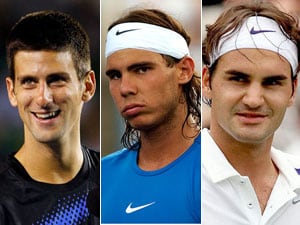Money, not ranking, exposes tennis players divide
It is a very different world to that inhabited by the top ranked players, as indicated by the figures in 2012. Recent estimates suggest that only 10% of the 1,800 male and 1,400 female professionals make a decent living out of the sport.
- Written by Agence-France Presse
- Updated: December 28, 2012 11:17 am IST
 Roger Federer and Maria Sharapova may have raked in a combined $100 million (75,658,378 euros) in prize money in their careers, but their rivals are struggling on the breadline.
Roger Federer and Maria Sharapova may have raked in a combined $100 million (75,658,378 euros) in prize money in their careers, but their rivals are struggling on the breadline.
Recent estimates suggest that only 10% of the 1,800 male and 1,400 female professionals make a decent living out of the sport.
"A player outside the top 20 often has no other source of income than their prize money," said Ukrainian player Sergiy Stakhovsky, who is ranked 103rd in the world.
It is a very different world to that inhabited by the top ranked players, as indicated by the figures in 2012.
Men's world number one Novak Djokovic won 9.7 million euros in prize money while his female equivalent, Victoria Azarenka won six million.
Those earnings are multiplied by sponsorship deals, appearance money and exhibition tournaments.
Sharapova earns an extra $20 million a year from endorsements.
Players ranked between 90th and 100th in the world won on average 202,970 euros in prize money in 2012 while it dropped to 75,000 euros for the 150th ranked player and just 20,780 euros for the 200th-rated player.
However, the expenses eat into those sums.
Tax can deduct up to 30% while travel costs, food, hotels, and the price of a coach nibble even more away.
Without the help of a federation, a patron or family, things can become stretched very quickly.
For some players it requires playing team tennis in France, Germany or Switzerland.
"It is with that money that I finance my competing in Australia (which gets underway in January)," admitted Frenchman Marc Gicquel, who is ranked 152nd in the world.
Even saving money for a rainy day or for when serious injury strikes can be tough.
"In order to put money on the side, you have to be in the top 50, stay there for a while and pay attention to your finances," said former professional player Arnaud Di Pasquale.
But some tournament officials insist that the top players do not help their fellow players with sky-rocketing demands for appearance money.
"They take at least 40% of the prize money and appearance money and when I say 40% I am being kind," one tournament director told AFP.
Whilst appearance money is officially forbidden on the WTA circuit it has been reintroduced on the ATP, so as to avoid below-par tournament line-ups.
However, it comes at a heavy price.
Former world number one Roger Federer can command an appearance fee of 800,000 euros at a tournament outside of a Grand Slam and the Masters series.
The Swiss legend has made an exception for just one tournament in the past few years -- his hometown one in Basel where 413,000 euros has been sufficient for him to play.
Some media reports claimed that he asked for double for 2013. That was turned down and Federer has removed it from his schedule.
Federer has just returned from South America where he played six exhibition matches, at one million dollars an appearance, according to the local media.
Some players are forced into debt even when, by most people's standards, they earn a respectable yearly income such as Claire Feuerstein, who is ranked 130 in the world and earned 71,317 euros last season.
However, once taxes and expenses were deducted, she was compelled to borrow money in June so that she could continue to compete on the circuit as there was just 200 euros in her account.
Di Pasquale said that the way things are going the sport could become more elitist in terms of player backgrounds.
"One has to pose the question if it is not obligatory now to be the son or daughter from a well-monied family to become a professional," he said.
